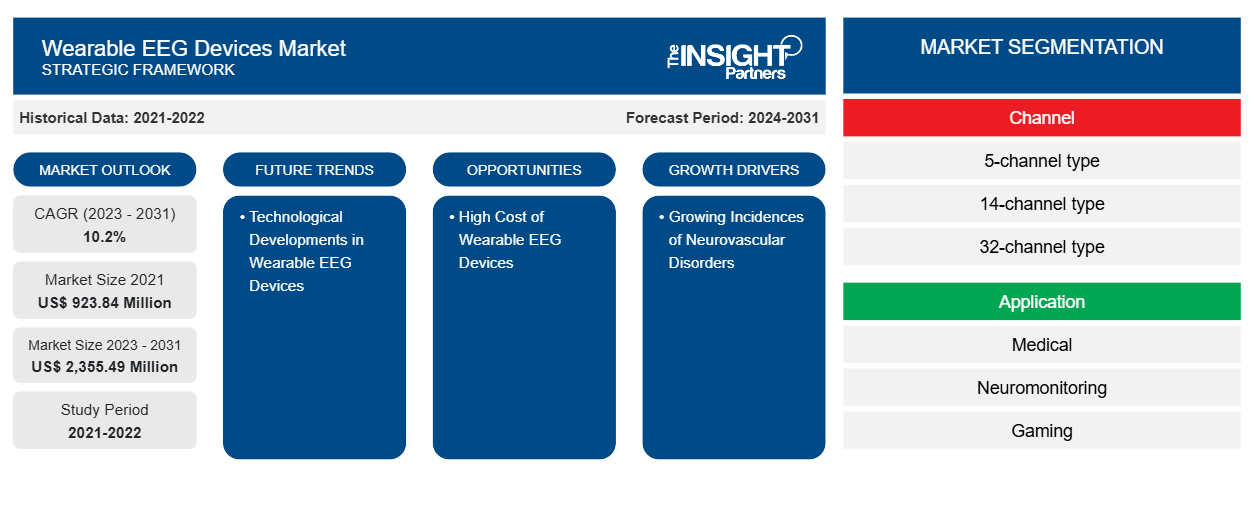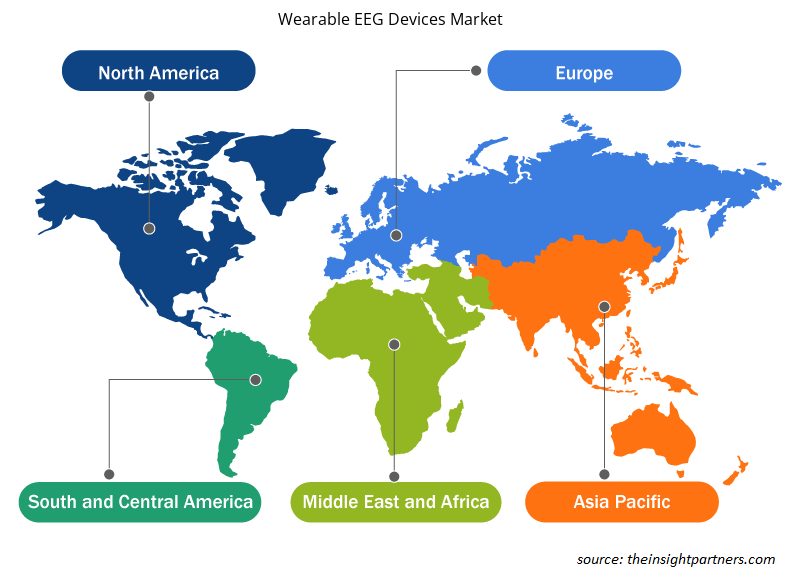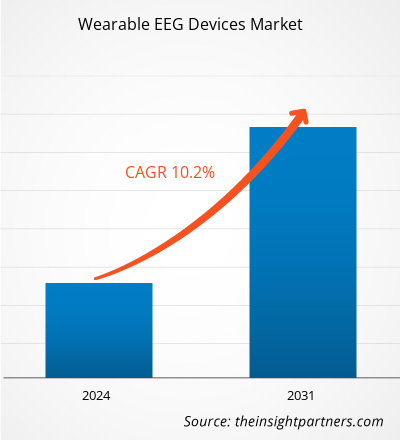Der Markt für tragbare EEG-Geräte soll von 396,17 Millionen US-Dollar im Jahr 2024 auf 695,51 Millionen US-Dollar im Jahr 2031 anwachsen. Für den Zeitraum 2025–2031 wird eine durchschnittliche jährliche Wachstumsrate (CAGR) von 8,7 % erwartet. Die Integration künstlicher Intelligenz dürfte in den kommenden Jahren neue Trends auf den Markt bringen.
Marktanalyse für tragbare EEG-Geräte
Tragbare EEG-Geräte sind fortschrittliche, nichtinvasive Systeme zur Echtzeitüberwachung und -aufzeichnung der elektrischen Gehirnaktivität. Im Gegensatz zu herkömmlichen EEG-Systemen, die typischerweise auf Krankenhäuser oder Kliniken beschränkt sind und eine komplexe Verkabelung erfordern, bieten tragbare EEG-Geräte Mobilität, Benutzerfreundlichkeit und kontinuierliche Überwachungsmöglichkeiten und eignen sich daher ideal für klinische und nicht-klinische Anwendungen. Diese Geräte bestehen aus kompakten, leichten Sensoren, die in Headsets, Kappen oder Bändern integriert sind. Sie erfassen Gehirnwellenmuster und übertragen die Daten drahtlos an Smartphones, Tablets oder Cloud-basierte Systeme. Die erfassten Daten können analysiert werden, um Anomalien zu erkennen, neurologische Erkrankungen zu beurteilen, mentale Zustände zu überwachen oder die kognitive Leistung zu optimieren. Die Integration mit künstlicher Intelligenz und maschinellem Lernen verbessert die Diagnosegenauigkeit zusätzlich und ermöglicht personalisierte Erkenntnisse.
Marktübersicht für tragbare EEG-Geräte
Die zunehmende Verbreitung neurologischer Erkrankungen, der technologische Fortschritt und die steigende Nachfrage nach nichtinvasiver Gehirnüberwachung in den Bereichen Gesundheitswesen, Gaming, Sport, akademische Forschung und anderen Sektoren treiben das Marktwachstum für tragbare EEG-Geräte voran . Im Januar 2024 entwickelten Forscher der Stanford University eine tragbare elektronische Kappe, die EEG-Signale interpretieren kann. Dieser Durchbruch ermöglicht es Nutzern, Roboter zu steuern, Aufgaben wie Putzen auszuführen, mit Roboterhaustieren zu interagieren und sogar einfache Mahlzeiten ausschließlich durch Gehirnaktivität zuzubereiten. Diese Fortschritte unterstreichen die wachsenden Anwendungsgebiete der EEG-Technologie über den klinischen Einsatz hinaus und verdeutlichen ihr Potenzial zur Verbesserung der Mensch-Maschine-Interaktion. Darüber hinaus trägt die alternde Weltbevölkerung maßgeblich zum Marktwachstum bei. Ältere Menschen haben ein höheres Risiko für neurologische Erkrankungen wie Alzheimer, Parkinson und Schlaganfall. Mit der steigenden Lebenserwartung steigt der Bedarf an kontinuierlicher Überwachung und effektivem Management altersbedingter Erkrankungen. Tragbare EEG-Geräte, die eine nichtinvasive Gehirnüberwachung in Echtzeit ermöglichen, sind ideal geeignet, um diese wachsende Nachfrage zu decken.
Sie erhalten kostenlos Anpassungen an jedem Bericht, einschließlich Teilen dieses Berichts oder einer Analyse auf Länderebene, eines Excel-Datenpakets sowie tolle Angebote und Rabatte für Start-ups und Universitäten
Markt für tragbare EEG-Geräte: Strategische Einblicke

-
Informieren Sie sich über die wichtigsten Markttrends in diesem Bericht.Dieses KOSTENLOSE Beispiel umfasst Datenanalysen, von Markttrends bis hin zu Schätzungen und Prognosen.
Markttreiber und Chancen für tragbare EEG-Geräte
Zunehmende geriatrische Bevölkerung
Fortschritte im Gesundheitswesen und ein verbesserter Lebensstandard erhöhen die Lebenserwartung und führen zu einem starken Anstieg der Zahl älterer Menschen weltweit. Laut WHO-Daten werden im Oktober 2024 bis 2050 80 % der älteren Weltbevölkerung in Ländern mit niedrigem und mittlerem Einkommen leben. Die Bevölkerung altert schneller als in früheren Generationen. Im Jahr 2020 überstieg die Zahl der über 60-Jährigen die Zahl der Kinder unter 5 Jahren. Darüber hinaus wird sich der Anteil der über 60-Jährigen an der Weltbevölkerung zwischen 2015 und 2050 voraussichtlich fast verdoppeln – von 12 % auf 22 %.
Mit der wachsenden Zahl älterer Menschen stehen Gesundheitsdienstleister vor der Herausforderung, chronische neurologische Erkrankungen zu behandeln, die oft eine langfristige Beobachtung der Gehirnaktivität erfordern. Herkömmliche EEG-Methoden, die typischerweise auf Krankenhäuser beschränkt sind, sind aufgrund ihrer Komplexität und Unbequemlichkeit weniger geeignet, den Bedarf dieser Bevölkerungsgruppe zu decken. Tragbare EEG-Geräte hingegen bieten eine komfortable, nichtinvasive und patientenfreundliche Lösung für die Echtzeit-Überwachung des Gehirns und ermöglichen eine kontinuierliche Datenerfassung zu Hause oder in der Gemeinschaft. Die steigende Nachfrage nach Lösungen für die Fernversorgung im Gesundheitswesen harmoniert gut mit den Möglichkeiten tragbarer EEG-Technologie. Diese Geräte unterstützen Telemedizin-Initiativen, indem sie Ferndiagnosen ermöglichen und die Häufigkeit von Krankenhausbesuchen reduzieren. Dadurch verbessern sie die Patientenergebnisse und senken die Gesundheitskosten. Die wachsende geriatrische Bevölkerung treibt somit die Nachfrage nach tragbaren EEG-Geräten voran.
Erweiterte Anwendungen in nicht-medizinischen Sektoren
Tragbare EEG-Geräte werden traditionell mit klinischen und neurologischen Anwendungen in Verbindung gebracht, doch ihre zunehmende Nutzung in nicht-medizinischen Bereichen bietet erhebliche Wachstumschancen für den Markt. Die Integration der EEG-Technologie in Verbrauchergesundheit, Gaming, Bildung, Produktivität am Arbeitsplatz und Neuromarketing erschließt neue Einnahmequellen und diversifiziert das Marktumfeld. Im Bereich Verbrauchergesundheit werden tragbare EEG-Geräte zunehmend zur Stressbewältigung, zur Verbesserung der Meditation, zur Schlafoptimierung und für andere Anwendungen eingesetzt. Geräte, die Gehirnströme in Echtzeit erfassen, ermöglichen es Nutzern, mentale Zustände zu überwachen und Techniken zur Verbesserung von Konzentration, emotionalem Wohlbefinden und kognitiver Leistungsfähigkeit anzuwenden. Dies entspricht der weltweit wachsenden Nachfrage nach personalisierten Gesundheits- und Mental-Wellness-Lösungen.
In Gaming und Virtual Reality (VR) werden EEG-fähige Headsets eingesetzt, um durch die Reaktion auf kognitive und emotionale Zustände des Spielers immersive Erlebnisse zu schaffen. Auch im Bildungsbereich wird EEG-Technologie erforscht, um Lernergebnisse durch Neurofeedback, Aufmerksamkeitstracking und kognitive Trainingstools zu verbessern, insbesondere für Schüler mit Lernschwierigkeiten. Auch Unternehmen setzen EEG-basierte Tools ein, um Stress, kognitive Belastung und Produktivität der Mitarbeiter zu überwachen und so das Arbeitsumfeld zu optimieren und die Leistung zu steigern. Im Neuromarketing liefern EEG-Geräte wertvolle Einblicke in das Konsumentenverhalten, indem sie unbewusste Reaktionen auf Werbung, Branding und Produktdesign messen. Diese nicht-medizinischen Anwendungen erweitern nicht nur die Kundenbasis, sondern reduzieren auch die Abhängigkeit vom traditionellen Gesundheitsmarkt und machen das Segment der tragbaren EEG-Geräte widerstandsfähiger gegenüber regulatorischen und Kostenerstattungsbeschränkungen. Da Gerätehersteller Benutzerfreundlichkeit, Design und Erschwinglichkeit kontinuierlich verbessern, wird erwartet, dass sich die Verbreitung tragbarer EEG-Geräte im nicht-klinischen Bereich beschleunigt und so langfristiges Marktwachstum und Innovation fördert.
Segmentierungsanalyse des Marktberichts für tragbare EEG-Geräte
Wichtige Segmente, die zur Ableitung der Marktanalyse für tragbare EEG-Geräte beigetragen haben, sind Produkt und Anwendung.
- Der globale Markt für tragbare EEG-Geräte ist nach Produkten in 32-Kanal-EEG, 14-Kanal-EEG, 5-Kanal-EEG und weitere unterteilt. Das 32-Kanal-EEG-Segment hielt im Jahr 2024 den größten Anteil am Markt für tragbare EEG-Geräte.
- Der globale Markt für tragbare EEG-Geräte ist nach Anwendung in die Bereiche Gesundheit und Wellness, adaptive Mensch-Maschine-Interaktion, Automobil, Luftfahrt, Industrie und andere segmentiert. Das Segment Gesundheit und Wellness hielt im Jahr 2024 den größten Anteil am Markt für tragbare EEG-Geräte.
Marktanteilsanalyse für tragbare EEG-Geräte nach Geografie
Der geografische Umfang des Marktberichts für tragbare EEG-Geräte ist hauptsächlich in fünf Regionen unterteilt: Nordamerika, Asien-Pazifik, Europa, Naher Osten und Afrika sowie Süd- und Mittelamerika.
Der asiatisch-pazifische Raum hatte 2024 einen bedeutenden Marktanteil. Der Markt für tragbare EEG-Geräte im asiatisch-pazifischen Raum steht vor einem rasanten Wachstum, wobei die zunehmende Verbreitung neurologischer Erkrankungen wie Epilepsie , Schlaganfall und Demenz ein wichtiger Treiber ist. Laut dem Bericht „Health at a Glance: Asia/Pacific 2024“ der Organisation für wirtschaftliche Zusammenarbeit und Entwicklung (OECD) stellen psychische Erkrankungen im asiatisch-pazifischen Raum eine erhebliche Herausforderung für die öffentliche Gesundheit dar und betreffen rund 475 Millionen Menschen, also etwa jeden siebten Menschen in der Region. Tragbare EEG-Geräte bieten kostengünstige, nichtinvasive Lösungen für Frühdiagnose und kontinuierliche Überwachung und decken so wichtige Gesundheitsbedürfnisse ab.
Die wachsende Gesundheitsinfrastruktur der Region, insbesondere in Japan und Südkorea, fördert die Einführung von Telemedizin und digitaler Gesundheit . Regierungsinitiativen wie Chinas Plan „Healthy China 2030“ fördern fortschrittliche Medizintechnologien. Die Initiative „Healthy China“ 2019–2030 ist eine umfassende nationale Strategie zur Verbesserung der öffentlichen Gesundheit und des Wohlbefindens in ganz China. Ihr Schwerpunkt liegt auf Krankheitsprävention, Gesundheitsförderung und der Beseitigung gesundheitlicher Ungleichheiten. Die Initiative umfasst 15 spezielle Kampagnen, wobei der Schwerpunkt auf der Bekämpfung nichtübertragbarer Krankheiten (NCDs) und der Förderung einer allgemeinen Krankenversicherung liegt.
Regionale Einblicke in den Markt für tragbare EEG-Geräte
Die Analysten von Insight Partners haben die regionalen Trends und Faktoren, die den Markt für tragbare EEG-Geräte im Prognosezeitraum beeinflussen, ausführlich erläutert. Dieser Abschnitt behandelt auch die Marktsegmente und die geografische Lage für tragbare EEG-Geräte in Nordamerika, Europa, Asien-Pazifik, dem Nahen Osten und Afrika sowie Süd- und Mittelamerika.

- Erhalten Sie regionale Daten zum Markt für tragbare EEG-Geräte
Umfang des Marktberichts über tragbare EEG-Geräte
| Berichtsattribut | Details |
|---|---|
| Marktgröße im Jahr 2024 | 396,17 Millionen US-Dollar |
| Marktgröße bis 2031 | 695,51 Millionen US-Dollar |
| Globale CAGR (2025 – 2031) | 8,7 % |
| Historische Daten | 2021-2023 |
| Prognosezeitraum | 2025–2031 |
| Abgedeckte Segmente |
Nach Produkt
|
| Abgedeckte Regionen und Länder |
Nordamerika
|
| Marktführer und wichtige Unternehmensprofile |
|
Marktteilnehmerdichte für tragbare EEG-Geräte: Auswirkungen auf die Geschäftsdynamik
Der Markt für tragbare EEG-Geräte wächst rasant. Die steigende Nachfrage der Endnutzer ist auf Faktoren wie veränderte Verbraucherpräferenzen, technologische Fortschritte und ein stärkeres Bewusstsein für die Produktvorteile zurückzuführen. Mit der steigenden Nachfrage erweitern Unternehmen ihr Angebot, entwickeln Innovationen, um den Bedürfnissen der Verbraucher gerecht zu werden, und nutzen neue Trends, was das Marktwachstum weiter ankurbelt.
Die Marktteilnehmerdichte beschreibt die Verteilung der in einem bestimmten Markt oder einer bestimmten Branche tätigen Unternehmen. Sie gibt an, wie viele Wettbewerber (Marktteilnehmer) in einem bestimmten Marktraum im Verhältnis zu dessen Größe oder Gesamtmarktwert präsent sind.
Die wichtigsten Unternehmen auf dem Markt für tragbare EEG-Geräte sind:
- BrainBit
- ANT Neuro
- Brain Products GmbH
- Electrical Geodesics, Inc. (Koninklijke Philips NV)
- EMOTIV
- g.tec medical engineering GmbH
Haftungsausschluss : Die oben aufgeführten Unternehmen sind nicht in einer bestimmten Reihenfolge aufgeführt.

- Überblick über die wichtigsten Akteure auf dem Markt für tragbare EEG-Geräte
Marktnachrichten und aktuelle Entwicklungen zu tragbaren EEG-Geräten
Der Markt für tragbare EEG-Geräte wird durch die Erhebung qualitativer und quantitativer Daten aus Primär- und Sekundärforschung bewertet, die wichtige Unternehmenspublikationen, Verbandsdaten und Datenbanken umfasst. Nachfolgend sind einige Entwicklungen im Markt für tragbare EEG-Geräte aufgeführt:
- BrainBit und ROOK freuen sich, eine neue Partnerschaft bekannt zu geben, die die Nutzung von Gesundheitsdaten revolutionieren soll. Die API von ROOK ermöglicht Entwicklern, Daten von Hunderten von Wearables, darunter jetzt auch BrainBit-Geräte, nahtlos in ihre Apps zu integrieren, zu verarbeiten und einzubetten. Diese Zusammenarbeit macht den hohen Entwicklungsaufwand für einzelne Integrationen überflüssig und ermöglicht es Teams, sich auf die Entwicklung wirkungsvoller Gesundheitslösungen zu konzentrieren. (Quelle: BrainBit Inc., Pressemitteilung, Juni 2024)
- Neuro XR (NXR) und Emotiv geben die Einführung der Emotional Heatmapping Technology bekannt, die die Analysesoftware von NXR mit den EEG-Geräten von Emotiv vereint. Diese Partnerschaft revolutioniert die Emotions- und Verhaltensanalyse und bietet Echtzeit-Einblicke in das Benutzerengagement. (Quelle: Emotiv, Pressemitteilung, Januar 2025)
Marktbericht zu tragbaren EEG-Geräten: Umfang und Ergebnisse
Der Bericht „Marktgröße und Prognose für tragbare EEG-Geräte (2021–2031)“ bietet eine detaillierte Analyse des Marktes, die die folgenden Bereiche abdeckt:
- Marktgröße und Prognose für tragbare EEG-Geräte auf globaler, regionaler und Länderebene für alle wichtigen Marktsegmente, die im Rahmen des Berichts abgedeckt sind
- Markttrends für tragbare EEG-Geräte sowie Marktdynamiken wie Treiber, Einschränkungen und wichtige Chancen
- Detaillierte PEST- und SWOT-Analyse
- Marktanalyse für tragbare EEG-Geräte mit wichtigen Markttrends, globalen und regionalen Rahmenbedingungen, wichtigen Akteuren, Vorschriften und aktuellen Marktentwicklungen
- Branchenlandschafts- und Wettbewerbsanalyse mit Marktkonzentration, Heatmap-Analyse, prominenten Akteuren und jüngsten Entwicklungen auf dem Markt für tragbare EEG-Geräte
- Detaillierte Firmenprofile
- Historische Analyse (2 Jahre), Basisjahr, Prognose (7 Jahre) mit CAGR
- PEST- und SWOT-Analyse
- Marktgröße Wert/Volumen – Global, Regional, Land
- Branchen- und Wettbewerbslandschaft
- Excel-Datensatz
Aktuelle Berichte
Verwandte Berichte
Erfahrungsberichte
Grund zum Kauf
- Fundierte Entscheidungsfindung
- Marktdynamik verstehen
- Wettbewerbsanalyse
- Kundeneinblicke
- Marktprognosen
- Risikominimierung
- Strategische Planung
- Investitionsbegründung
- Identifizierung neuer Märkte
- Verbesserung von Marketingstrategien
- Steigerung der Betriebseffizienz
- Anpassung an regulatorische Trends






















 Kostenlose Probe anfordern für - Markt für tragbare EEG-Geräte
Kostenlose Probe anfordern für - Markt für tragbare EEG-Geräte